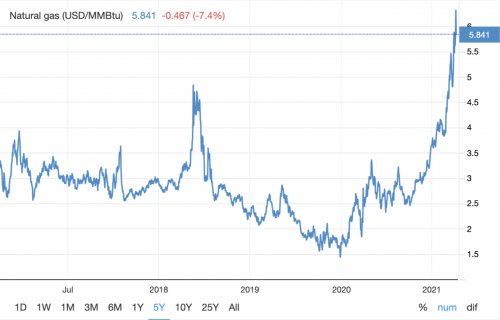Natural gas futures hit a 12-year high Tuesday as supply constraints collided with forecasts of a nationwide cold front, a perfect storm for rising prices, Marketwatch reported. At $6.312 per million British thermal units, prices were 180 percent higher than a year ago.
New York landlords are less than a week into the city’s heating season. With gas supplies down 15 percent year-over-year and La Niña expected to produce a rough winter, some are bracing for a financial hit.
But for owners squeezed by falling revenue and rising costs since the pandemic began, a higher heating bill is just another brick in the wall.
Read more


Under city law, landlords must provide heat starting Oct. 1. As soon as daytime temperatures slide below 55 degrees Fahrenheit, the thermostat must read at least 68 degrees. The regulations extend through May 31, two-thirds of the year, and affect the majority of homes. Nearly 70 percent of downstate New York, which includes the city, Westchester and Long Island, depends on natural gas for power.
“There’s a very big concern if operating costs go up for real estate,” said David Schwartz, principal and co-founder of Slate Property Group. “Specifically, coming out of Covid, a lot of people had a really hard time. Tenants are still having a hard time paying rent and landlords lost a tremendous amount of revenue.”

source: tradingeconomics.com
In market-rate apartments, Schwartz said, landlords will likely offset the higher heating costs by raising rents. For stabilized units, he ventured that the Rent Guidelines Board would likely hike rates at its annual June vote.
For this season, owners will be left out in the cold. The board voted to freeze rents from Oct. 1 until mid-spring, when a 1.5 percent hike would kick in.
At the time, landlords complained the hike would not cover their rising bills, among them property taxes, insurance and utilities.
Now, as radiators heat up, Ann Korchak of the landlord group Small Property Owners of New York said it’s hard to fixate on the potential for a higher gas bill when the cost of everything has gone up.
“Today I got the renewal proposals for my insurance umbrella policy. It went from just under $3,000 to $6,400,” she said. “We’re worried about every price going up and then we’re in an inflationary environment, too, so we have that added pressure.”
Schwartz, too, said that while heating costs are a worry, they’re coupled with the rising prices of services and materials, as inflation rates edged higher throughout the summer.
Last week, Federal Reserve Chair Jerome Powell told Congress that inflation had run longer than the central bank had anticipated, and projected it would continue through next year.
“It’s difficult to say how those effects will be in the meantime or how long they will last,” he said.
Rising heating costs likely won’t hit property owners immediately. Service providers such as Con Edison purchase gas through long-term contracts with set prices to shield customers from volatility, CNN reported.
Natural gas forecasts also show prices easing moderately through the end of the year into 2022.
source: tradingeconomics.com
And to curb the impact of higher prices, most natural gas facilities have dual-fuel capacity, which allows them to switch to petroleum if it’s less expensive. However, recent projections have oil spiking “off the charts” as winter approaches, according to CNBC.
If and when sustained natural gas costs do rub off on owners, it will be the small ones — as usual — who bear the brunt.
“Larger organizations typically have some flexibility built into their structure, where if their costs run over, they are well-capitalized.” said Schwartz. “I think it hits the mom-and-pop owners harder.”
